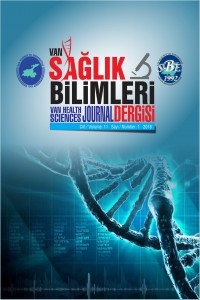İnsan, Koyun, Sığır Echinococcus granulosus İzolatlarında Protoskoleks Çengel Morfolojilerinin Karşılaştırılması
Echinococcus granulosus, Hydatid cyst, Protoscolex, Hook, Morphology
Comparison of Protoscolex Hook Morphologies in Human, Sheep, Cattle Echinococcus granulosus Isolates
Echinococcus granulosus, Hydatid cyst, Protoscolex, Hook, Morphology,
___
- Ahmadi N, Dalimi AJI (2006). Characterization of Echinococcus granulosus isolates from human, sheep and camel in Iran. Genetics and Evolution, 6, 85-90.
- Ahmadi N (2004). Using morphometry of the larval rostellar hooks to distinguish Iranian strains of Echinococcus granulosus. Parasitology, 98, 211-220.
- Aksu M, Kırcalı Sevimli F, İbiloğlu İ, Bozdoğan Arpacı R (2013) Mersin ili’nde kistik ekinokokkozis (119 olgu). Türkiye Parazitoloji Dergisi, 37, 252-256.
- Almeida F, Oliveira F, Neves R, Siqueira N, Rodrigues-Silva R, Daipert-Garcia D et al. (2015). Morphometric characteristics of the metacestode Echinococcus vogeli Rausch & Bernstein, 1972 in human infections from the northern region of Brazil. Journal of Helminthology, 89, 480-486.
- Almeida F, Silva RR, Neves R, Gonçalves M, Romani E, da Silva JRMC (2009). Morphological and morphometric studies on protoscoleces rostellar hooks of Echinococcus granulosus from Peru visualized by several microscopic techniques. Neotropical Helminthology, 3, 65-71.
- Aydın M, Adıyaman G, Doğruman-Al F, Kuştimur S, Ozkan S (2012). Determination of anti-echinococcus IgG antibodies by ELISA in patients with suspected hydatid cyst. Türkiye Parazitoloji Dergisi, 36(2), 61-64.
- Beyhan YE, Umur Ş (2011). Molecular characterization and prevalence of cystic echinococcosis in slaughtered water buffaloes in Turkey. Veterinary Parasitology, 181, 174-179.
- Elmajdoub LO, Rahman WA, Fadzil M, Mohd SA (2014). Studies on the protoscoleces and hooks of Echinococcus granulosus from Libya by scanning electron microscope. Acta Medica International, 1, 74-81.
- Eslami A, Shayan P, Bokaei S (2014). Morphological and genetic characteristics of the liver hydatid cyst of a donkey with Iran origin. Iran Journal of Parasitology, 9, 302-310.
- Gordo FP, Bandera CC (1997). Differentiation of Spanish strains of Echinococcus granulosus using larval rostellar hook morphometry. International Journal for Parasitology, 27, 41-49.
- Harandi MF, Hajialilo E, Shokouhi M (2012). Larval hook length measurement for differentiating G1 and G6 genotypes of Echinococcus granulosus sensu lato. Türkiye Parazitoloji Dergisi, 36, 215-218.
- Hobbs R, Lymbery A, Thompson RC (1990). Rostellar hook morphology of Echinococcus granulosus (Batsch, 1786) from natural and experimental Australian hosts, and its implications for strain recognition. Parasitology, 101, 273-281.
- Hussain A, Maqbool A, Tanveer A, Anees A (2005). Studies on morphology of Echinococcus granulosus from different animal-dog origin. Punjab University Journal of Zoology, 20, 151-157.
- IBM Corp. Released 2011. IBM SPSS Statistics for Windows, Version 20.0. Armonk, NY: IBM Corp. Latif A, Tanveer A, Riaz-Ud-Din S, Maqbool A, Qureshi AW (2009). Morphometry of protoscoleces rostellar hooks of Echinococcus granulosus isolates from Punjab, Pakistan. Pakistan Journal of Science, 61, 223-228.
- Latif AA, Tanveer A, Maqbool A, Siddiqi N, Kyaw-Tanner M, Traub R (2010). Morphological and molecular characterisation of Echinococcus granulosus in livestock and humans in Punjab, Pakistan. Veterinary Parasitology, 170, 44-49.
- McManus D, Thompson RC (2003). Molecular epidemiology of cystic echinococcosis. Parasitology, 127, 37-51.
- Mustafa I, Shahbaz M, Asif S, Khan MR, Saeed U, Sadiq F, Mehmood T, Ahmed H, Simsek S (2015). Availability, cyst characteristics and hook morphology of Echinococcus granulosus isolates from livestock (cattle, sheep and goats) in Central Punjab, Pakistan. Kafkas Universitesi Veteriner Fakultesi Dergisi, 21, 849-854.
- Singh BB, Sharma JK, Tuli A, Sharma R, Bal MS, Aulakh RS et al. (2014). Prevalence and morphological characterisation of Echinococcus granulosus from north India. Journal of Parasitic Diseases, 38(1), 36-40.
- Sweatman G, Williams R (1963). Comparative studies on the biology and morphology of Echinococcus granulosus from domestic livestock, moose and reindeer. Parasitology, 53(3-4), 339-390.
- Yıldız K, Gurcan IS (2009). The detection of Echinococcus granulosus strains using larval rostellar hook morphometry. Türkiye Parazitoloji Dergisi, 33(3), 199-202
- ISSN: 2667-5072
- Başlangıç: 2018
- Yayıncı: Van Yüzüncü Yıl Üniversitesi
Çocuklarda Akut Gastroenterit Etkenlerinin Mevsimsel Farklılığı
Anne Yaşının Erken Çocukluk Çağı Üzerine Etkilerinin İncelenmesi
Ahmet Cemil TALMAÇ, Bilal EGE, Nazlı Zeynep ALPASLAN, Metin ÇALIŞIR
Kolostomi Kapatılmasında daha kabul edilebilir görünüm için farklı yaklaşımlar
Burhan BEGER, Lokman SOYSAL, İbrahim ÖZALP, Ozan OKYAY, Serhat BİNİCİ, Fırat ASLAN
Muslih ÜRÜN, Gürkan GÜNER, Yasin SEZGİN, Emre UYSAL, Yonca YILMAZ ÜRÜN, Abdullah SAKİN
Ahmed Galip HALİDİ, Hasan YİLMAZ, Yunus Emre BEYHAN
Yoğun Bakım Ünitelerinde Basınç Yarası Gelişimini Etkileyen Faktörler
Tiroid Nodüllerinin Yönetiminde İnce İğne Aspirasyon Biyopsisine Ne Zaman ve Ne Kadar Güvenmeliyiz?
Oğuzhan HAMZADAYI, Gamze ÇAKMAK
Farklı Maloklüzyon Gruplarında Ortodontik Tedavi İhtiyacının Belirlenmesi
